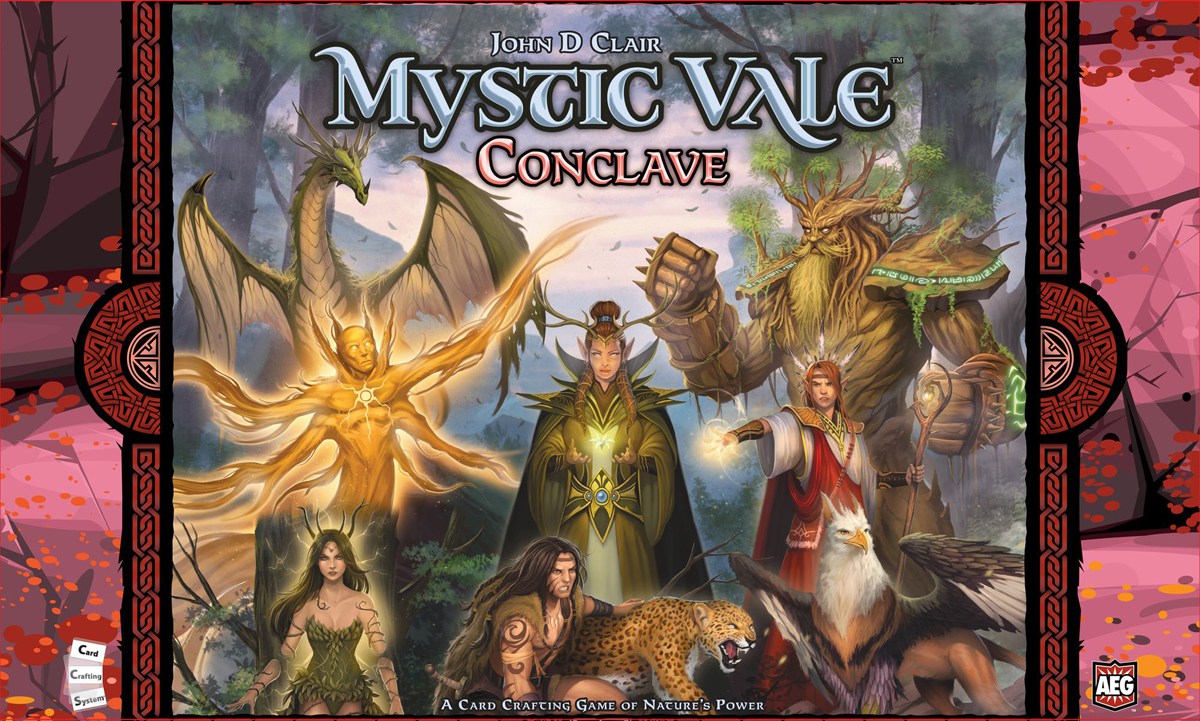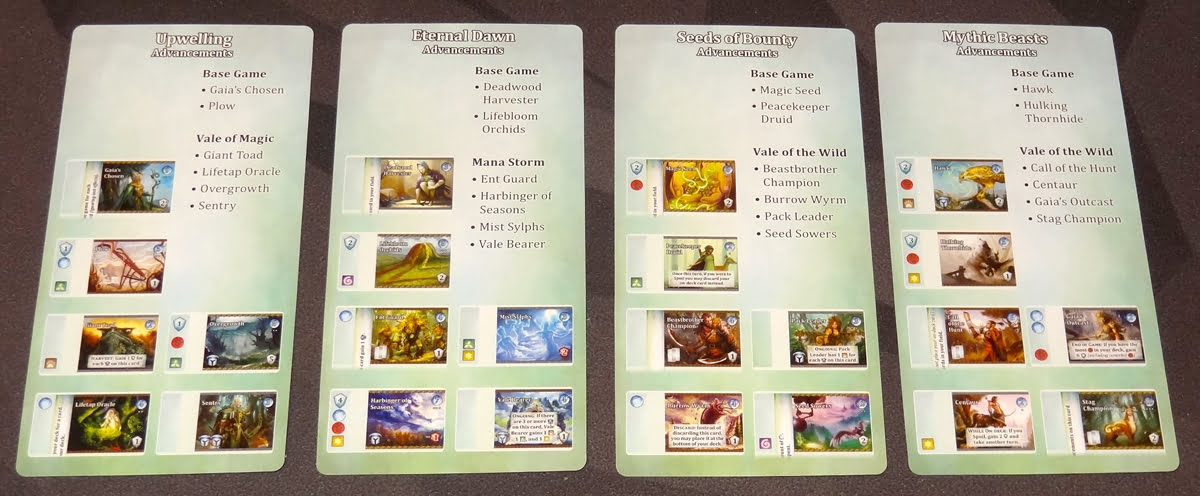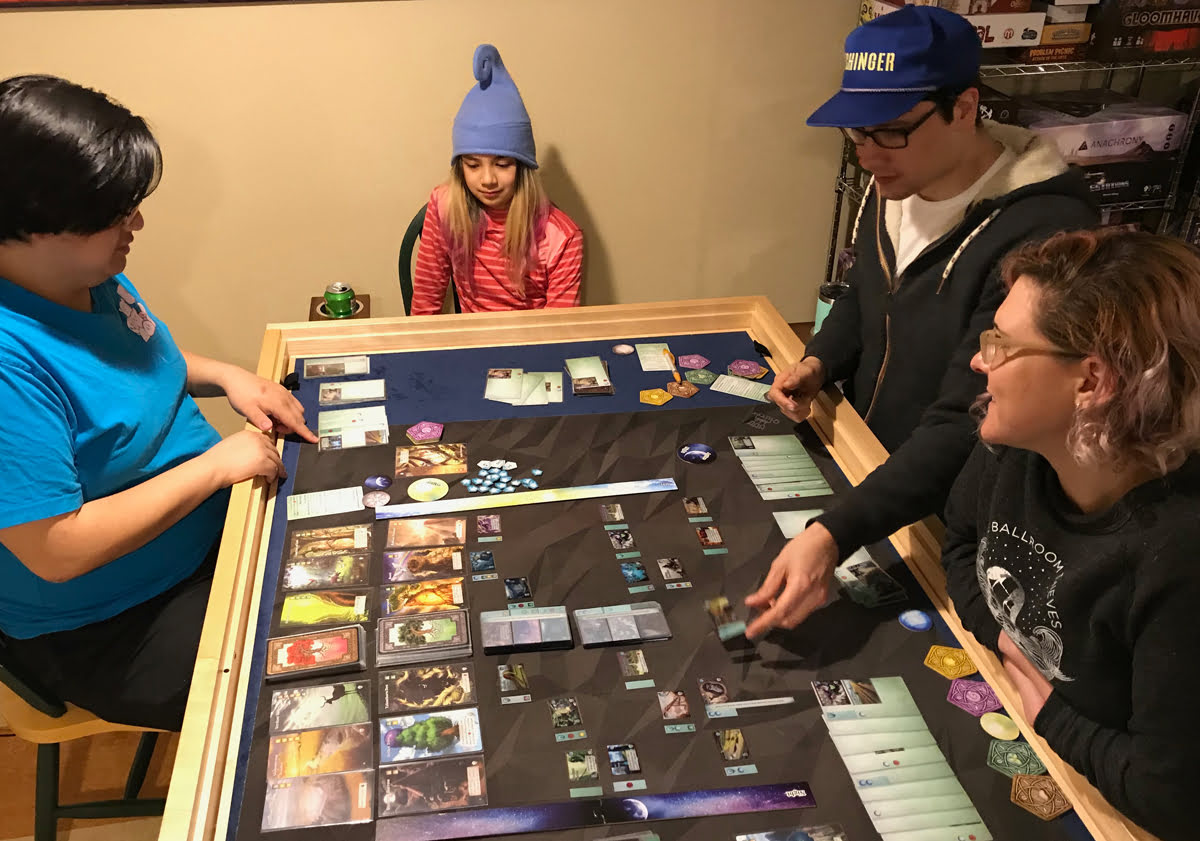 Mystic Vale expands again, with new clans joining the ranks, powerful totems, and the arrival of equinox.
Mystic Vale expands again, with new clans joining the ranks, powerful totems, and the arrival of equinox.
What Is Mystic Vale: Conclave?
Mystic Vale: Conclave is an expansion for Mystic Vale for 2 to 6 players, ages 14 and up, and takes about 45 minutes to play. It retails for $49.99, and is available now in game stores, from Amazon, or directly from AEG. Note that since this is an expansion, you need the base game to play—read my review of Mystic Vale here. Although the box says “14 and up,” I’ve played this with my 11-year-old and she picked up on it and really enjoys it; it helps to have a little experience with deck-building games, but it’s not required.
The major features introduced in this expansion: the game now accommodates up to 6 players (instead of 4), the “Equinox” setup speeds up play, and the box provides storage for all of your expansions.

Mystic Vale: Conclave Components
- 24 Spirit counters (4 counters each for 6 players)
- 40 starting cards (20 cards each for 2 players)
- 12 Totem cards
- 34 dividers
- 14 Conclave cards
- Active Night token
- Active Day token
- Starting Night token
- Starting Day token
- Night border
- Day border
- 2 mana tokens
- 20 VP tokens
- 100 card sleeves
- 1 BIG BOX

Okay, let’s start with the last item on the list there: the big box. Conclave is the fourth expansion for Mystic Vale, so if you’ve been collecting all of them you’ve run out of space in the base game box for everything. The box for Conclave is big enough to hold all of the expansions, and then some. The three narrow card boxes are tall enough to hold the tarot-sized cards (and the even taller dividers) vertically. In the picture above, I have the base game, Vale of Magic, and Conclave, and you can see that it just barely fills one of the three boxes. To the side of those are stacked two plastic trays for all of the other bits: mana tokens, the new spirit counter tokens, and point tokens.
The box is quite large—it’s approaching Gloomhaven size, and looks almost absurdly large to me. I suppose if there will eventually be enough Mystic Vale expansions to fill the other two boxes, it makes sense, but currently I kind of wish the box had stored the cards on their sides and was half as tall.
There aren’t any new advancement or vale cards in this set, as there have been in previous sets. Instead, there are two more sets of starting cards (with purple backs and white backs), and a set of Totem cards, which I’ll explain later.

I do have some nitpicky issues with some of the new cardboard components. The night and day borders are each two strips of cardboard that connect, puzzle-style. Except, as you can see in the photo above, the puzzle parts weren’t cut exactly right, so the borders are slightly crooked and misaligned when you put them together. The other issue is that, as you can see in my photo of the box above, the border pieces are just ever-so-slightly too long to lay across the box sideways. (And they’re too long to lay flat in one of the card boxes, too.)

The spirit counters are large cardboard pentagons, numbered from 0 to 9 on the two sides, and are just used to help you keep track of the spirit symbols you gain and spend during your turn. They’re not necessary for gameplay and don’t add a new rule, but for players who manage to generate a bunch of them on a turn, they’re nice to track how much you’ve spent. The one annoying thing about these is that they’re not actually regular pentagons: if you stack them so they’re all oriented the same way, they’re fine, but as soon as you rotate one, you’ll notice that they don’t quite line up anymore.

The night and day tokens are also large cardboard disks, almost coaster-sized. Each one says “Active” on one side and “Waiting” on the other. What’s strange to me is that the day token doesn’t say “Day” on the active side—that seems like an oversight.
Generally, none of my complaints here affect the actual gameplay, but it does seem like a little more attention to detail would have been nice.
The divider cards separate all the various card types: advancements, starting cards, vales, totems, and so on. There are also a lot of extra divider cards included, so that if you want to create particular sets of cards, you can have multiple “Level 1 Advancements,” for instance.
What’s New in Mystic Vale: Conclave
You can download a copy of the rulebook here.
The basic gameplay is still the same as the original, so I’ll refer you to my initial review for that, and just introduce what’s new in this expansion.

Totems
The totems give each player new abilities. Each player is dealt two totems at setup and chooses one to keep, placing it face-up in front of them. Totems are like vales in that they’re not shuffled into your deck, but stay face-up throughout the game.
Most totems have some symbols on them—these are active on each turn, as if you’ve harvested them, so you may get spirit symbols or mana or extra points. Each totem also has one or more powers that can be activated during specific phases of your turn. For instance, the Elemental Totem provides one of each basic spirit symbol, and allows you to add a vale to the commons during your planting phase so that you have more options to choose from.

Conclave Cards
The conclave cards are lists of advancements and vales that will adjust the mix of cards for different play styles. If you decide to use them, you’ll choose 6 conclave cards, and use only the advancements and vales listed on those cards. (Vales are listed on the back of each card.) The cards indicate whether advancements are from the base game or an expansion, so you can ignore those from expansions you don’t have. The extra dividers can be useful for keeping a particular setup separated out.

Equinox Setup
The equinox setup is perhaps the biggest game-changer in Conclave, and is intended to speed up the gameplay significantly.
When setting up the commons area, you still make one deck of each card type: three levels of advancements, and two levels of vales. However, instead of revealing three of each advancement type for the commons, you reveal six: three for the night commons and three for the day commons, marking the two commons with the border strips. (You also reveal eight of each vale type instead of four—my photo above is missing a few.) Give the starting player the active night token and the starting night token. Give the day tokens to the player across the table from them.
When it’s your turn, you can only buy from the commons that matches your night/day token. If you have card effects that target other players, you may only target your immediate neighbors. When your turn is over, you flip the token to the “waiting” side and pass it clockwise. When both tokens are “waiting,” the players holding them flip them to the active side and take their turns.
The game end is triggered as usual, when the points tokens run out. Continue playing until all players have had the same number of night turns and day turns (as indicated by the smaller starting night and day tokens).

Why You Should Play Mystic Vale: Conclave
I really enjoy Mystic Vale, though prior to Conclave I had only played with the base game and the first expansion. It’s a fascinating mix of deck-building with AEG’s Card Crafting System, and I love the way that you’re building your cards as you play, not just adding more cards to your deck. I also like the way that there are multiple approaches: focusing on spirit symbols to buy powerful vales, reducing decay so that you can draw more cards, playing cards that let you take points right away, and so on.
My favorite part of the Conclave expansion is the equinox variant, because it speeds up play significantly. With two players taking their turns simultaneously, it essentially halves the game length, with minimal changes to setup and gameplay. It’s the equinox setup that allows for 5- and 6-player games, which would have too much downtime in between turns. With equinox, even a 6-player game doesn’t have a lot of waiting. It’s definitely made me more likely to get it to the table or suggest it for a game night. (You can use the equinox setup even in a two-player game, but it’s not entirely necessary and can get a little confusing.)
The downside is that, in a game that can feel a little like “multiplayer solitaire,” the simultaneous play makes it even easier to ignore what other players are doing and just stay focused on your own card-crafting. There’s still the same type of interaction mediated through the commons—buying something that you think somebody else may want—but it can be harder to do since you’re switching commons every turn. The other tricky part is that, because there two separate commons, you can sometimes have the issue where you have enough mana or spirit symbols to afford the card you want … but it’s on the wrong side.
The equinox setup does take a bit more table space, too. The rulebook offers two layouts depending on your table size, but there’s no way to make it really compact, since you’ll need space for 40 tarot-sized cards in some arrangement, not to mention space for each player to have their fields.
The totem cards are a nice addition: they give players a little starting boost toward a particular strategy, and add a little asymmetry to the game. I’ve only seen a couple of the totems in action so far, but they do change the game quite a bit and have some really interesting effects.
Currently, since I don’t have all the other expansions, I don’t use the conclave cards. I don’t know how much I’d really want to sort through the piles of advancements and vales and sort them out each time I played the game, but I could see using them if I were taking a subset of Mystic Vale cards on a trip. It’s a way to balance out the randomness that can come with a huge market deck that’s all shuffled together, and make it more likely to get certain combos working.
Despite my complaints about some of the components, I think Conclave is an excellent addition to the Mystic Vale line. It doesn’t feel quite like a typical expansion, but instead is more like a very good supporting accessory. Overall, if you’re already a fan of Mystic Vale (and particularly if you have a few of the expansions), I think you’ll really appreciate Conclave. If you were on the fence and felt there was too much downtime in the game, you’ll want to give the equinox setup a try—it might just change your mind! On the other hand, if you don’t normally find yourself with 5 or 6 players and you’re fine with the current length of the game and your storage solutions, Conclave may not be necessary for you.
Click here to see all our tabletop game reviews.
If you’d like to stay up-to-date with all of our tabletop gaming coverage, please copy this link and add it to your RSS reader.
Disclosure: GeekDad received a copy of this game for review purposes.





